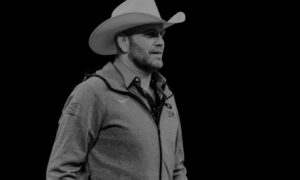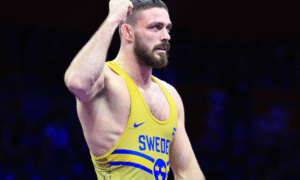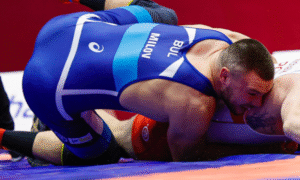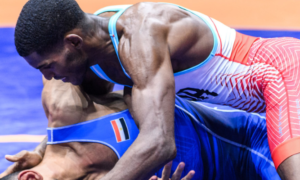“Last year, I came on this trip as an extra and didn’t know what to expect, as it was my first time out of the country and I ended up doing pretty well. This year is my first year at NMU and these past few months have really helped me. I came back to Sweden hungry for more and I noticed a big performance boost in myself.” — Riley Briggs (66 kg, NMU/OTS)
If the now-annual fall tour of Sweden is supposed to do anything, it is to elicit reactions like that. We could go on here (and will), but Briggs, who finished fourth on Sunday at the Malar Cupen in Västerås, said it best.
The success of the tour, which wrapped up over the weekend with the aforementioned Malar Cupen, cannot be adequately measured merely by highlighting all of the medals won and victories achieved. Those are part of it and will be recognized in full shortly. But for United States Greco-Roman competitors, especially the younger and more inexperienced of the lot, it’s about making improvements at home before going overseas and testing out what’s working.
Full-time Greco athletes in this country come with a difficult job description. Domestic competition often fails to represent what the highest level of the sport looks like internationally. That doesn’t mean full-timers always prevail over part-timers — certainly not. But by and large, matches between good wrestlers who focus on the style and those who don’t tend to be one-sided affairs which do little to actually prepare one for the jump in skill level prevalent at international events. That is where the disconnect lies. A capable wrestler can smash through domestic opponents only to find that the resistance present in Europe, Asia, or wherever and whenever, is unlike anything they encounter when at home.
So it’s simple — true “Greco guys” who do not have the opportunity to train and compete overseas are usually receiving a false reading. They may get their hands raised on US soil, but become altogether flummoxed when the result is entirely different after their passports are stamped. The only way to combat that is, of course, obvious — gather an appropriate baseline. Domestic tournaments have their place, particularly in regards to qualifying for Trials events or making World Teams. But when the most skilled Greco-Roman wrestlers on the planet reside elsewhere, opportunities to learn from and compete with them have to be taken advantage of, at least until the US hosts enough of its own depth to render that concept unnecessary. It’s going to take a minute.
The US brought around three dozen wrestlers to Sweden two weeks ago. Not all of them got matches in, though most did. It’s a developmental tour based more around training than competition, primarily because you count the competition as part of the training experience. The benefits are so pronounced, they’re difficult to get a handle on. For young, full-time, devoted Greco athletes like Briggs or George Sikes (85 kg, NMU/OTS), it is vitally important to gain first-hand knowledge that what is being taught to them in Marquette translates on a foreign mat. Or you could take someone like Tommy Brackett (85 kg, TN), who is a well-known prospect but still prepping for his high school folkstyle season, and flip it around. Brackett has been overseas a few times the last two years. He won’t be able to immerse himself fully in Greco until 2018, but he has already been stocking valuable, relevant experience under his belt for when that happens.
However, the most effective (and popular) way to get a pulse of where the United States Greco-Roman program stands developmentally is by glancing at results. With two (really three) team titles and 14 medalists spread across three international events this month, that’s easy enough to accomplish.
Proof positive
If you remember, it all started three weeks ago in Denmark. That’s when Alston Nutter (69 kg, NMU/OTS) ran roughshod over the field at the Bear Cup while teammate/friend Benji Peak (63 kg, NMU/OTS) earned bronze after staging an exhilarating comeback. Nutter and Peak got a headstart on their American teammates in more ways than one. The duo was already in Denmark for nearly two weeks before the NMU head coach Rob Hermann arrived with the rest of the US delegation in Sweden, where everyone came together for the Klippan Cup.
Led by two-time Junior World Team member Randon Miranda (59 kg, NYAC/OTS), Team USA emerged victorious at the Klippan Cup with three medalists — Miranda had one close match but was virtually lights out in picking up gold, Nick Boykin (130 kg, Sunkist) netted a solid win over a tough, older opponent en-route to silver, and Peak checked in with his second consecutive bronze. Peyton Robb (76 kg, Minnesota Storm) placed fourth after losing out to Lukas Ahlgren (SWE) in wild, high-scoring bout, but he’d be heard from again, and in a big way.
Next up for the US was a dual meet against Team Skåne Brottning, and the argument could be made that this was the watershed moment of the tour.
In the 2016 edition of the dual, USA wrestlers won just three out of 10 matches. 2017 did not offer a repeat. With Austin Almaguer (58 kg, WA) providing the spark and behind big wins from Britton Holmes (71 kg, NMU/OTS) and Robb, who exacted his revenge on Ahlgren by nearly tech’ing him, Team USA won the meet by one match, and that came courtesy of Dominic Damon (63 kg, WA) emphatically putting an end to the proceedings by forcefully disposing of Zackarias Gustavsson (TSB). They call these things “friendly duals”, but is there really such a thing when there’s a point to be made, as there was in this case? The US, collectively, is trying to show that the program is facing a different direction and a dual win over a foreign club that beat the brakes off you the year before seems like it would suffice.
Finally, this past weekend’s Malar Cupen threw an exclamation point on both the tour and the US-developmental-improvement narrative itself. Three champs — Miranda, Peak, and Robb — together with nine other medalists helped propel the US to victory in both the Cadet and Junior/Senior age groups, a first time occurrence.
If you go back and look at 2016, this year’s results appear to be a natural next step, except for one notable exception: only one wrestler who medaled last year did so again in 2017 — Hunter Lewis, who is now a two-time bronze medalist at the Malar Cupen. Everyone else, including Miranda, the most high-profile of the group, was a first-time placewinner. Other medal winners from ’16’s tour such as Logan Kass, Austin Morrow, G’Angelo Hancock, and Jesse Porter, were not around this year so there were a whole lot of fresh faces.
A side-by-side comparison between 2016 and 2017 makes it all appear even more startling.
- 2016 Klippan Cup — Two champions: Jordan Auen (59 kg, NMU/OTS) and G’Angelo Hancock (98 kg, Sunkist); one bronze: Jesse Porter (75 kg, NYAC/OTS); Team USA finishes in second place.
- 2017 Klippan Cup — One champion: Randon Miranda (59 kg, NYAC/OTS); one silver: Nick Boykin (130 kg, Sunkist); one bronze: Benji Peak (59 kg, NMU/OTS); Team USA finishes in first place.
- 2016 dual vs. Team Skåne Brottning — USA wins three of ten matches in the dual and loses both bonus matches.
- 2017 dual vs. Team Skåne Brottning — USA takes eight of fifteen matches to win outright.
- 2016 Malar Cupen — One champion: Britton Holmes (69 kg, NMU/OTS); three silvers: Austin Morrow (66 kg, NYAC/OTS), Logan Kass (71 kg, NMU/OTS), and G’Angelo Hancock (98 kg, Sunkist); one bronze: Hunter Lewis (50 kg, WI); Team USA finishes third in Cadet standings and fourth in the Senior standings.
- 2017 Malar Cupen — Three champions: Randon Miranda (59 kg, NYAC/OTS), Benji Peak (63 kg, NMU/OTS), and Peyton Robb (76 kg, Minnesota Storm); two silvers: Carter Nielsen (80 kg, NMU/OTS) and Nick Boykin (130 kg, Sunkist); four bronze: Hunter Lewis (58 kg, WI), Dominic Damon (63 kg, WA), Tommy Brackett (85 kg, TN), and Spencer Wilson (98 kg, NMU/OTS); Team USA wins both Cadet and Senior age groups.
The training camps are important, as is Sweden enthusiastically working together with the US to be able to provide these opportunities. However, the American wrestling community is a results-oriented one and coming back home after two weeks of education and no medals doesn’t exactly inspire confidence among the uninitiated. Fans, family members, uninformed journalists — whomever — can only tell a process is working when there is data to back it up.
The summer saw Kamal Bey (80 kg, Sunkist, world no. 18 at 75 kg) and Cohlton Schultz (100 kg, NYAC) win World titles, and an unlikely Cevion Severado (50 kg, MO) capture a World silver. Those three played a huge role in raising awareness around the country. Following three World medals up with a hugely satisfying haul from the Sweden tour should hopefully serve to further establish what everyone has been talking about, which that things are different now and this is just the beginning.
Schultz Notes
The 2017 Dave Schultz Memorial provided a glimpse at what the US Senior Greco-Roman circuit is going to look two months from now thanks to the tournament breaking out the new weight classes, but that also caused some confusion, at least around here. Our previews were off the mark. Several wrestlers competed at different weights than originally projected (or declared), so there was some catching up to do once the event began. For that, we apologize.
As for the actual living, breathing wrestling itself, there were several spotlight performances.
The US had only two champions, John Stefanowicz (82 kg, Marines) and Hayden Zillmer (97 kg, Minnesota Storm), but both of their finals bouts made for compelling theater. Stefanowicz did battle with Dillon Cowan (Army/WCAP) and by battle, you could take that literally. These two last met in February at the Armed Forces Championships and it was the absolute best match of the Army/Marines dual, if not the entire event. Cowan won that affair, he scored four on a counter as Stefanowicz tried a lateral, but that was in the first period. The rest of the time they chipped, clubbed, snapped, and brutalized each other in the ties.
It wasn’t too different on Thursday night, except for the result. Stefanowicz snuffed out an arm throw attempt early on to score two and he did so again later in the first before turning over a gutwrench. Stefanowicz received a passivity point soon into the second, and that’s when physicality started to enter into the equation. Whether Cowan got called for leading with his head or raking an elbow, it was rather tough to tell. Either way, it was a caution-and-two, and that ballooned Stefanowicz’s lead to 9-2. One more step-out ended the bout late in the third, a somewhat surprising tech win for Stefanowicz.
No, there was not a lot of dynamism at play in the match, but there didn’t need to be. It was two wrestlers going out there ready to fight and that’s what they did. Cowan’s caution didn’t seem unfair, but it also didn’t seem as if he was trying to dirty things up. He’s an athlete better known for being technical, but he can brawl, too. When we’re talking about Stefanowicz, he is on the other end of that spectrum. Stefanowicz is a brawler by trade who is now at a stage in his career where the technical finer points are starting to mesh with the aggression. These two just seem to match up well, though it’s a wonder if they will again any time soon since Cowan has spent the majority of his Senior career a weight class lower.
Zillmer has now done this twice. At June’s Ljubomir Ivanovic-Gedza International in Kragujevac, Serbia, Zillmer was behind by a point to Stjepan Lavoric (CRO) with half a minute remaining when he dipped down, got to Lavoric’s body, and then crushed him to his back for the dramatic fall to nail down bronze. If you watch the sequence, Lavoric looked like his back was about to break from the force. He landed in apparent agony.
Thursday’s circumstances varied slightly, but not by much. Going for gold against 2010 Junior World silver/2012 Olympian Lee Se-Yeol (KOR), Zillmer was down by three due to a late caution with under a minute left. The action up until the reckoning was suspenseful but ultimately, rather uneventful, too. They swapped passivity calls. The caution loomed large, obviously, so Zillmer had no choice but to keep making attempts. One high dive didn’t work, neither did the next one. But when Zillmer finally got inside, he made it count. He crunched his arms around Lee and boomed him straight to his back on the edge for four and had no problem avoiding a banana peel in whatever was left of the second period to walk away the winner.

Zillmer (top) tries to get around Lee Se-Yeol (KOR) in the 87 kg finals of last week’s Dave Schultz Memorial in Colorado Springs. (Photo: Alec Ortiz/House 8 Graphics)
- Jamel Johnson (Marines) put forth an impressive effort in his own right. Competing at 72 kilograms, Johnson lost his first match on Wednesday to 2016 Olympian Tomohiro Inoue (JPN) but won his next two bouts to advance to the bronze medal round, where he defeated talented neophyte Brandon Mueller (505 Wrestling Club) 2-1. A University World bronze medalist five years ago, Johnson is as tough as anyone in the country when he’s staying active, so let’s hope this is the start of a trend for him.
- 2012 Junior World bronze medalist/2016 Olympian Jesse Thielke (63 kg, NYAC) dropped his first bout to Mostafa Hassan Mohamed (EGY) but bounced back and then some to win bronze with three tech’s and a pin. The man he beat for bronze, Sammy Jones (NYAC/OTS), also looked plenty fearsome throughout the tournament, especially by edging Hassan in the consolation semis. Jones can do this, he has all the supposed required tools. 63 might be a good look for him going forward.
- Khymba Johnson (87 kg, NYAC/OTS) got himself a nice dose of revenge with a jaw-dropping 10-1 tech fall of 2016 US National champ Kevin Radford (Sunkist). Radford defeated Johnson twice last year — first in the finals of the Open and again in the semis of February’s version of the Schultz.
- Korea brought a lot of wrestlers to the US for this event and perhaps unsurprisingly, did quite well. A Korean wrestler appeared in eight of the ten finals matches (including round-robins).
Seniors in Belarus
As we reported last week, the US currently has a group of seven Seniors in Belarus for a training camp and the Oleg Karavaev tournament, set for November 17th in Minsk. A dual meet between the US and a Belarusian team was previously mentioned by US National Team head coach Matt Lindland as a possibility, but we’re still awaiting word if/when that is going to happen.
What’s Coming Up Here
- An interview featuring 2011 Junior World bronze medalist and multiple-time National Team member Toby Erickson (130 kg, Army/WCAP). The big guy earned a bronze at Zagreb in March, finished second to Robby Smith (NYAC) at the Trials (which we’ll crack open), and then placed third last week at Schultz. There’s a lot to discuss with Erickson both on and off the mat, so that is something to look forward to.
- We check in with 2016 World Team member Chris Gonzalez (77 kg, NYAC), who ventured into an MMA career following his runner-up performance at the ’17 Trials. Gonzalez returned for the Schultz tournament where he engaged in a fun-but-frustrating-at-times-to-watch bout with RaVaughn Perkins (NYAC) in the semis and later fought back for third with a win over John Yeats (CAN).
- Cody Pack (72 kg, Legends of Gold) will also be talked to this week. One of USA Greco’s most eager and proficient scorers, Pack also comes from a decorated folkstyle collegiate career and wields some interesting insights regarding training and competition.
- An update on Lucas Sheridan (87 kg, Army/WCAP), who endured an injury to his chest over the summer and is just now rounding back into form.
- Two age-group wrestlers on the rise — Camden Russell (55 kg, MWC) and Tyler Cunningham (63 kg, MWC) entered the Dave Schultz Memorial, so we’re going to see what they have to say about their first forays into major Senior competition.
Questions? Concerns? Feel like reaching out? Do so on Twitter, Facebook, and Instagram!
SUBSCRIBE TO THE FIVE POINT MOVE PODCAST
iTunes | Stitcher | Spreaker | Google Play Music | RSS
















